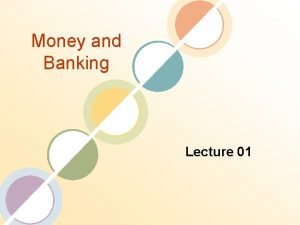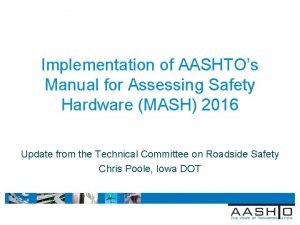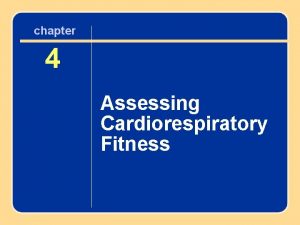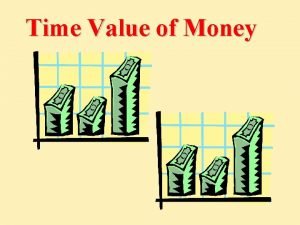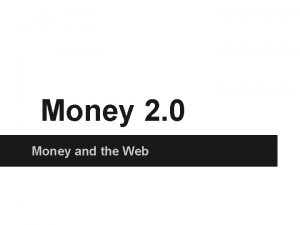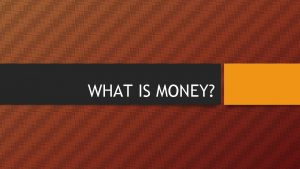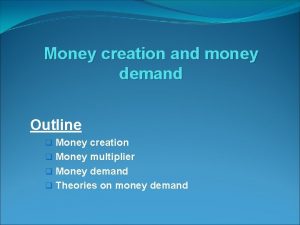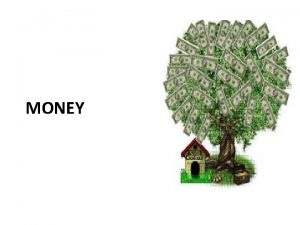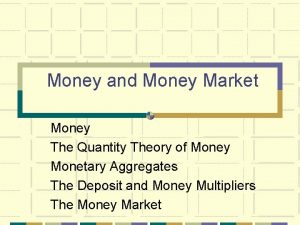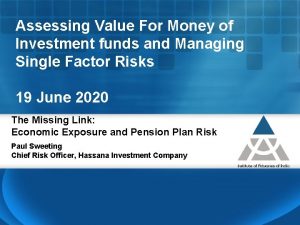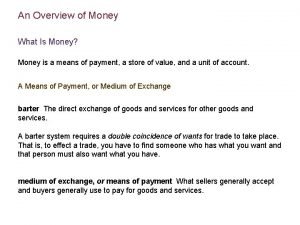Assessing value for money principles methods and issues


























- Slides: 26

Assessing value for money: principles, methods and issues Professor Nancy Devlin City Health Economics Centre n. j. devlin@city. ac. uk

1. The role of value for money arguments in purchasing decisions • NHS (and private) health care providers make strategic decisions based largely on the business case Ø Ø • HRG tariff price vs. average cost Risk assessment The demand for providers’ services is determined by PCT spending decisions Ø Ø Ø Exercising some degree of discretion, Within the constraints of their funding and various requirements and obligations PCT decision making will increasingly be informed by value for money considerations As are decisions by, for example, NICE Reflects a growing emphasis, in NHS policy, on outcomes (rather than activity)

2. Principles • Economic assessments of value for money have two distinctive characteristics: Ø Opportunity costs Ø A focus on marginal analysis • Focussing on changes in costs (and benefits) at the margin gives important insights that can be obscured by average or total costs (and benefits)

3. Insights from Marginal Analysis Example 1: Cost savings from early discharge Source: Drummond et al. (2006) Methods for the Economic Evaluation of Health Care Programmes

4. A decision making exercise The Government says that it will earmark a sum for the prevention of two diseases (Disease A and Disease B) that are prevalent in your PCT. These diseases are sometimes fatal, but can be prevented by suitable procedures. You are asked to advise on how to spend the money to maximise the number of premature deaths averted.

The Government hints that the sum will be £ 1 million. You ask public health experts, who tell you that the number of premature deaths averted by spending £ 1 million would be: 49 for disease A or 101 for disease B What would you advise?

The Government now tells you that, at the insistence of the Treasury, the sum will actually be £ 500, 000. Again you ask public health experts, who tell you that the number of premature deaths averted by spending £ 500, 000 would be 39 for disease A or 81 for disease B What would you now advise?

Government documents on this decision, including your advice, are leaked before a crucial by-election in your region. The Government announces publicly that they will, after all, make £ 1 million available. What would you now advise?

Deaths averted Average Cost A B Total A B £ 1 m 49 101 £ 20, 408 £ 9, 901 £ 0. 5 m 39 81 81 £ 12, 821 £ 6, 173 £ 1 m 39 81 120 £ 12, 821 £ 6, 173

Disease A Disease B Deaths averted Cost per death averted 100 000 10 10 000 26 3 846 200 000 19 10 526 43 4 651 300 000 27 11 111 58 5 172 400 000 34 11 765 70 5 714 500 000 39 12 821 81 6 173 600 000 43 13 953 87 6 897 700 000 46 15 217 92 7 609 800 000 48 16 667 96 8 333 900 000 49 18 367 99 9 091 1 000 49 20 408 101 9 901 Total cost (£)

Cost A B Total Marginal MC £ 0. 5 m 39 39 £ 12, 821 81 81 £ 6, 173 £ 1 m £ 0. 5 m 49 10 £ 50, 000 101 20 £ 25, 000 MC = Marginal cost per death averted

Disease A Disease B Deaths averted Marginal cost per death averted 100 000 10 10 000 26 3 846 200 000 19 11 111 43 5 882 300 000 27 12 500 58 6 667 400 000 34 14 286 70 8 333 500 000 39 20 000 81 9 091 600 000 43 25 000 87 16 667 700 000 46 33 333 92 20 000 800 000 48 50 000 96 25 000 900 000 49 100 000 99 33 333 1 000 49 101 50 000 Total cost (£)

800, 000 700, 000 300, 000 200, 000 100, 000 90, 000 80, 000 70, 000 60, 000 50, 000 40, 000 30, 000 20, 000 10, 000 0 0 100, 000 200, 000 300, 000 400, 000 500, 000 600, 000 Amount spent on disease A Disease B 700, 000 800, 000 900, 000 Marginal cost per death averted 900, 000 Amount spent on disease B 600, 000 500, 000 400, 000

5. Optimisation rules: the equimarginal principle Marginal Benefit, Marginal Cost £ MC MB Q 2 Q* Q 1 ØThe optimum quantity is Q* where MB = MC At Q 1, MC > MB At Q 2, MB > MC Quantity of medical care

6. Principal Methods Economic evaluation is: ‘The comparative analysis of alternative courses of action in terms of both their costs and consequences’ • • • Cost minimisation (CM) Cost-benefit analysis (CBA) Cost-effectiveness analysis (CEA) Cost-consequences analysis (CCA) Cost-utility analysis (CUA)

Method How are benefits measured? How are results expressed? What is the decision making rule? Proven equal £ Choose that which costs least Cost Benefit Analysis £ Net present value (NPV) in £ Benefit cost ratio NPV > 0 B: C ratio > 1 Cost Effectiveness Analysis Natural units, e. g. pain free days life years gained Cost effectiveness ratio (CER)= Costs/ outcome That with the lowest CER is best value for money* Cost Consequences Analysis In a variety of different natural units. CERs for each alternative measure of effectiveness That with the lowest CER is best value for money* Cost effectiveness ratio= Costs/ QALYs That with the lowest CER is best value for money* Cost minimisation Quality Adjusted Cost Utility Analysis Life Years (QALYs) * and those with a CER lower than society’s ‘threshold’ CER are desirable

7. Quality adjusted Life Years • A measure of outcome which incorporates both quality and length of life. • Can capture changes in quality of life, length of life or both • Facilitates comparisons between health care services with very different effects upon health • Estimating QALYs, changes in QALYs and cost per QALY gained

8. What are costs and benefits estimated against? The ‘counterfactual’ is: • • The position against which costs and consequences are compared The position to which costs and consequences are incremental (or marginal) Relevant counterfactuals might include: • • • Best practice Current practice (the status quo) ‘Do nothing’ (e. g. best supportive care)

The importance of the choice of comparator Table 1. cost effectiveness analysis including Drug B QALYs ΔQALYs Cost (£ 000) Δcost Cost/QALY gained Palliative care 0. 4 1 1 2. 5 Drug A 0. 6 0. 2 2 1 5 Drug B 0. 7 0. 1 10 8 80 Drug C 0. 8 0. 1 13 3 30 Δcost Cost/QALY gained Intervention Table 2: Cost effectiveness analysis excluding Drug B Intervention QALYs ΔQALYs Cost (£ 000) Palliative care 0. 4 1 1 2. 5 Drug A 0. 6 0. 2 2 1 5 Drug C 0. 8 0. 2 13 11 55 Using Drug B as the comparator means attributing spurious cost effectiveness to Drug C

9. How is quality of life measured? Measuring health on a generic HR-Qo. L instrument: the EQ-5 D

10. How is quality of life valued? Example of a ‘tariff’ of social values (a value set) for the EQ-5 D

11. Methods for eliciting values: The time trade-off method (TTO) Ø Offer choice between: Ø x years of full health Ø t years at health state i Ø At the point of indifference, the value of health state i is hi = x/t VALUE OF HEALTH Healthy = 1 State i = hi Dead = 0 x t YEARS

12. The cost effectiveness plane Difference in effect and cost of an option relative to its comparator IV + cost Intervention less effective and more costly I - effect + effect Intervention more effective and less costly III - cost II

13. NICE decision making: the £ 30, 000 question • What is the basis for NICE’s cost effectiveness threshold? • Are NICE recommendations out of keeping with real budget constraints in the NHS? • What are the opportunity costs of services displaced by new technologies? • Is NICE efficiency increasing?

14. Investment and disinvestment in the NHS • The cost effectiveness thresholds in local NHS decision making (The ‘Williams Project’: Appleby, Devlin, Parkin, Buxton and Chalkidou, 2007) • • • Services ‘at the margin’ identified: investment, disinvestment, deferred investment Exclude: invest-to-save; decisions which are dominant on CE grounds. CUA performed on remainder • A preview of results • Implications for value for money judgements. • What health services are ‘at the margin’ in your organisation?

15. Outcomes-based management • BUPA’s experience with using the SF-12 to manage the performance of clinical staff/teams • Use of routine health outcome measures in the NHS (Appleby and Devlin 2004)
 Assessing value for money
Assessing value for money Dana damian
Dana damian Penciptaan nilai adalah
Penciptaan nilai adalah Symbols in the great gatsby
Symbols in the great gatsby Money smart money match
Money smart money match Money on money multiple
Money on money multiple Satire in the great gatsby
Satire in the great gatsby How is daisy described in the great gatsby
How is daisy described in the great gatsby Assessing grammar effectively
Assessing grammar effectively Domain 4 curriculum
Domain 4 curriculum Informal vs formal assessment
Informal vs formal assessment Assessing a new venture's financial strength and viability
Assessing a new venture's financial strength and viability Assessing leadership and measuring its effects
Assessing leadership and measuring its effects Module 4 topic 1 assessing and managing risk
Module 4 topic 1 assessing and managing risk Module 4 topic 1 assessing and managing risk
Module 4 topic 1 assessing and managing risk Indirect wax pattern
Indirect wax pattern Personal finance basics and the time value of money
Personal finance basics and the time value of money Present and future value of money
Present and future value of money Five core principles of money and banking
Five core principles of money and banking Five core principles of money and banking
Five core principles of money and banking Teacher dominated approach
Teacher dominated approach Btec sport level 3 unit 3
Btec sport level 3 unit 3 Unit 18 assessing children's development support needs p1
Unit 18 assessing children's development support needs p1 Task analysis in hrd
Task analysis in hrd Manual for assessing safety hardware
Manual for assessing safety hardware Cultural dynamics in assessing global markets
Cultural dynamics in assessing global markets Assessing cardiorespiratory fitness
Assessing cardiorespiratory fitness



















